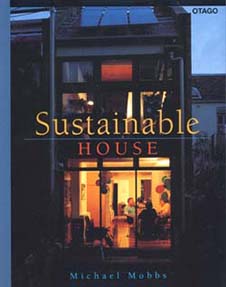Living for Our Future
Michael Mobbs
 The book
The book
Sydney's first self-sufficient house offers a blueprint for future urban living. The house gets energy from the sun, water from the rain, and takes care of its waste disposal needs. It is off mains water supply, puts solar electricity back into the main electricity grid, recycles all water on the property, and processes all sewage on site.
This house is the subject of Sustainable House. It is not a new house. Author Michael Mobbs and partner Heather Armstrong began a standard kitchen and bathroom renovation of their ordinary terrace house in inner-city Sydney, and ended up with revolutionary adaptations to the dwelling which made it 'sustainable'. It didn't cost the earth, and feels like an ordinary home.
We all know the environmental problems engendered by large cities. And most of us are all too aware of the cost of the services, inadequate as they may sometimes be, that we depend on. Often the infrastructure needs upgrading – and that is making the services cost even more. Sustainable House shows us that there is another way to live in our urban homes, and it is practical and possible.
The Mobbs/Armstrong family has been undisturbed by the Sydney water crisis because of their self-suffiency, and yet they live only two kilometres from the city centre. If they'd been in inner-city Auckland during the power crisis, they would have continued having hot showers, using their computer and eating refrigerated food.
In Sustainable House Michael Mobbs tells the story of how all this was achieved – he includes full details of costs, with a cost-benefit analysis from an accountant. He provides information that will help other people who have no building, engineering or design skills to build or renovate their own sustainable house. He describes the techniques and solutions which worked – and those that didn't. Being an environmental lawyer helped in his case – he gives advice on obtaining local authority and government approvals.
A plus of the book is that because members of the author's family suffer from occasional asthma and allergies to dust mites these conditions were taken into account in the renovations. Mobbs and his partner improved the ventilation of their home, sought to avoid materials made of PVC or which discharged toxic chemicals, and tried to consider the health risks of everything they used. As well, they endeavoured to use either timbers that were recycled or from plantation forests, to lessen the larger environmental impact of their home. Full details of the materials they used are given in the appendices.
Another feature of the book is the information it gives about research into water quality and quantity in an urban environment. For a city like Auckland, this is a vital question for householders considering their options. The Mobbs/Armstrong household has been the focus of a study by the University of Technology in Sydney since it set up its own water supply/recycling system. With the help of these experts, the household is moving towards water being recycled for drinking as well as washing.
Sustainable House is clearly written, easy to understand, with numerous photographs and diagrams. It includes useful lists of products, contacts and suppliers, and a reference list for further reading. It's an inspiring example of what one household can do to help the world.
The author
MICHAEL MOBBS lives in Chippendale, Sydney with his wife Heather Armstrong and their two children. He has worked as a lawyer in his own practice, specialising in environmental law and policy. He was an associate lecturer in environmental law at the University of Technology, Sydney, and has served on the Sydney City Council. He was the founding editor of what became the New South Wales Law Handbook and of the Environmental Law Reporter (1980).
Publication details
Large format illustrated paperback, 280 x 216 mm, 192 pages, ISBN 0 877133 62 0, $45
Co-published with ChoiceBooks, a division of the Australian Consumers' Association
1998
Out of print
